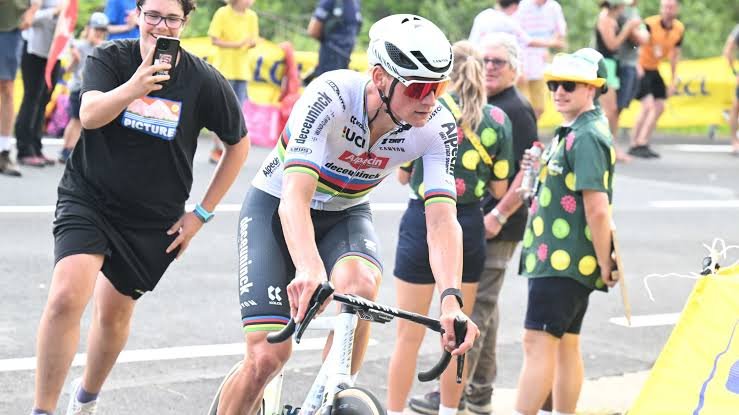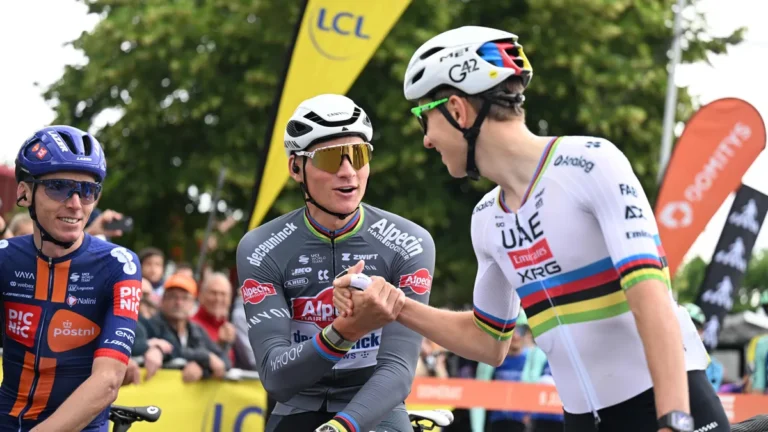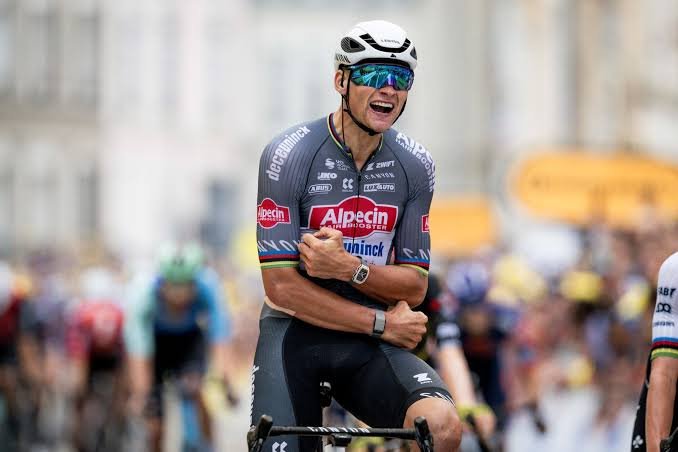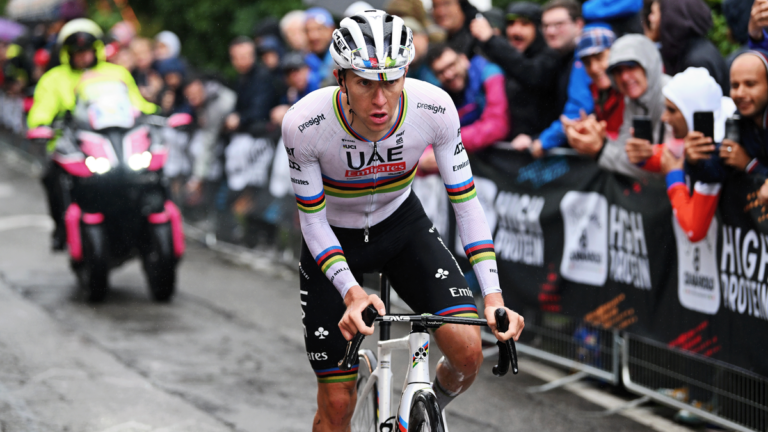
Mathieu van der Poel (Alpecin-Deceuninck) raised concerns regarding the increase of riders in the Tour de France peloton, going from 176 to 184 for 2025, as the UCI introduces a 23rd team and eight additional riders across all three Grand Tours starting this season.
As the debate about safety in the peloton continues, Van der Poel commented on the safety concerns during his pre-Tour press conference, highlighting the presence of more riders in the pack as a possible risk.
When asked if he feels unsafe in the current peloton, Van der Poel responded: “This doesn’t change much; I believe it will always be risky in the group, regardless of any additions.”
Often, it’s the behavior of the riders themselves that contributes to the situation, which is typical, as you all compete for the same spot and space is limited.
This is something that will always remain in cycling, but perhaps expanding the group is a misstep; I believe fewer teams and fewer riders will genuinely make a significant difference.
Following the addition of an extra wildcard team for the 2025 season, the UCI announced a permanently-expanded peloton size in June, based on suggestions from the Professional Cycling Council (PCC).
In attendance at the PCC meeting was Adam Hansen, president of the Cyclistes Professionnels Associés (CPA), the riders’ union, who elaborated on the decision and its feasibility regarding safety, speaking to Cyclingnews following the UCI announcement.
Reasons included the fact that the peloton would not return to its former limit of 198, and that the character of the additional squad being a second division ProTeam altered the appearance of an extra eight riders.
In 2017/18, we lowered it by 22 riders, and now we have raised it by eight riders. “It’s not a significantly different change,” Hansen mentioned to Cyclingnews last month.
“The main reason the CPA endorsed this is primarily due to the ProTour teams.” It’s a significant advantage for a ProTour team to compete in Grand Tours, clearly benefiting their sponsors and the long-term viability of these teams.
“We viewed it as typically, following the first week, you usually see around five to ten riders leave due to early crashes.” Thus, an increase of eight is not significant. While losing a single rider from each team was significant, the difference between 22 riders out and just 8 returning is far more substantial.
Hansen also stated that he had talked to multiple riders regarding the possible concerns, and that the feedback, in contrast to Van der Poel’s two days prior to the Tour, was favorable.
In conversations with riders, a few mentioned that it’s not that big of an issue since the additional team is a ProTour team, meaning they’re not truly at the forefront battling, so to speak, in the most critical danger moments during the race,” Hansen noted.
“These teams are participating in the initial breakaways and simply gaining television exposure.” They play a distinct role in the sport, thus their impact isn’t particularly significant. From the viewpoint of the rider, there isn’t much of a difference.
“It would be distinct if you were introducing an additional WorldTour team where they compete at the front with another complete lead-out train, and something similar, but it’s not genuinely like that.” “It’s merely a Pro Tour squad.”
Hansen also has experience from the Giro d’Italia, which operated with a similarly strong peloton of 184 riders in May, and he received no specific complaints afterward, with the major crashes in the Giro occurring due to slippery conditions and challenges of the gravel stage in Tuscany.
“I never received any negative comments regarding the additional size in the Giro, and the Giro itself went quite well,” he stated.
“The mass crash we witnessed was not due to an overly large peloton, but rather the icy, slippery roads, which heightened the risk of collisions.”
While the UCI and CPA maintain that the slight increase in rider count is justified and manageable, Van der Poel’s concerns underscore the continued tension between logistics and rider safety. The Dutchman’s remarks also reflect a broader skepticism among some high-profile riders, particularly those with strong classics and sprint backgrounds, where positioning and pack density often make the difference between success and a crash.
The initial 10 stages of the 2025 Tour are anticipated to be grueling, with the terms ‘hectic’, ‘chaotic’, and ‘nervous’ reverberating from nearly every cyclist’s pre-race discussion when inquired about their approach to the combination of sprint stages and challenging finishes.
Van der Poel’s inquiry about a larger peloton size might not be the only one from the competitors, but the verdict on whether the UCI, PCC, and CPA made the right choice won’t be clear until the tumult of the Tour fully develops on the route.
The early part of the Tour is traditionally the most crash-prone, with riders scrambling for position, often in urban finishes and narrow countryside roads. With an expanded peloton, there’s concern that the margin for error in tight corners, sprint setups, and exposed crosswind sections will further shrink.
Van der Poel, known for his aggressive and skilled riding style, particularly in the classics and punchy finales, is no stranger to the dangers of a dense peloton. His call for fewer teams and a reduced group echoes sentiments shared by other riders over the years who have advocated for a more streamlined Grand Tour field to prioritize safety.
However, the commercial and structural reality of professional cycling complicates the issue. The inclusion of a 23rd team provides crucial opportunities for second-tier ProTeams to gain visibility and showcase talent, a factor that can’t be dismissed in a sport increasingly driven by sponsor value and team development.
The CPA’s support of the move, driven by its own consultations with riders and team representatives, indicates a more complex consensus behind the scenes. Hansen’s point that most withdrawals occur in the early stages—and that the eight additional riders may be neutralized by early abandonments—adds another layer to the argument.
Yet critics argue that relying on attrition to resolve overcrowding is an unsatisfactory approach. If early crashes are expected and used as a statistical justification, it raises questions about whether enough is being done to proactively protect rider safety rather than reactively manage it.
Additionally, the argument that ProTeams are less likely to be in the thick of the action can be misleading. In chaotic first-week stages, even riders from wildcard squads find themselves in the middle of sprint finishes, crosswind splits, and general GC shuffles. A crash doesn’t discriminate based on team level, and as seen in previous editions, a moment’s mistake can involve a dozen riders or more, regardless of their standing.
Ultimately, while Van der Poel’s statement might be seen as a cautious warning, it also serves as a reminder that the sport must continually evolve not just for entertainment and development, but also for the safety of those risking everything on the road. The UCI’s balancing act between growing the sport and ensuring manageable, secure race conditions remains under intense scrutiny.
As the 2025 Tour de France unfolds, eyes will be closely watching how the expanded peloton impacts the flow, safety, and drama of the race. Whether the UCI’s gamble with the size increase pays off or leads to renewed debate will depend largely on what unfolds over the Tour’s unpredictable and high-stakes opening week.



